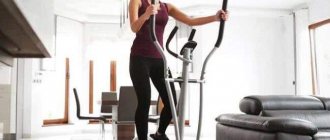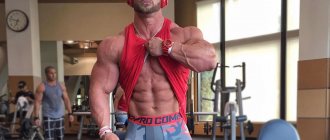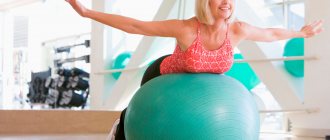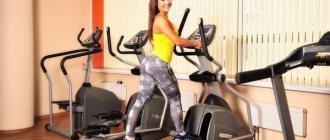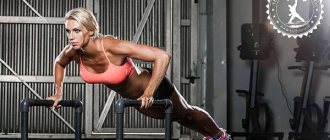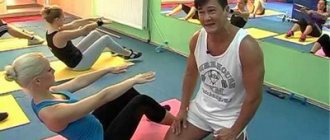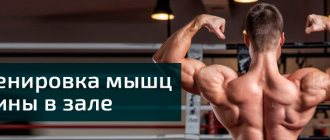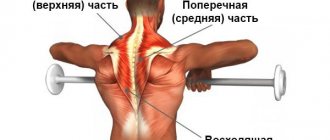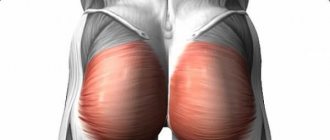Now it has become fashionable to take care of the health and beauty of your body. The number of gym visitors is steadily growing. If you also decide to go in for sports, then you should know how to properly exercise in the gym. First of all, you should pay attention to the choice of a training room, in particular to the competence of the trainer. After all, only a professional will help you choose the exercises and techniques that are right for you, and this is the key to time spent usefully. And remember, a good gym is not about new flooring and free water. The main thing in this case is the ability to achieve the desired result. A good gym should have a full set of basic exercise machines (including presses), benches for pressing, barbells with dumbbells, a large selection of handles and dumbbells, as well as mirrors.
After choosing a gym for training, you need to think about clothes for training. The main requirement here is that clothing does not restrict movement. If we talk about fabric, then avoid synthetics, which are poorly breathable and have a negative effect on the skin. It is better to purchase special shoes, but if this is not possible, then opt for comfortable sneakers with good performance.
Features of muscle physiology
To understand how to exercise correctly in the gym, you should consider that muscle groups consist of slow and fast fibers. The former are responsible for the breakdown of fats, the latter for the consumption of glucose. The number and ratio of muscle fibers are the same and do not change throughout life. An effective gym program includes exercises that will keep your muscles under constant tension. When we exercise, muscle fibers are stretched and torn. The more the muscles are stretched, the faster the fibers will grow.
Rules of etiquette
Keep in mind that you are not alone in the gym, so you shouldn’t arrogantly take those equipment and climb onto those machines that you need. To avoid problems and behave correctly, follow a few basic recommendations:
- if you are asked to act as a backup, then be sure to do so. If you are not confident in your abilities (for example, you will not be able to lift this or that whole thing on your own if something happens), then it is better to admit it right away;
- if an athlete is training in front of a mirror, then do not stand in front of it and do not block the view;
- You should not use the exercise machine for a long time. On average, it takes about 25-30 seconds to complete one approach, after which you can step away from the exercise for a while and let another person do the exercise. As soon as you have completed your exercise, return the weight of the person doing the exercise at the same time as you;
- You don’t need to wear a lot of scent while hiking. If everyone starts dousing themselves in cologne or perfume, then it will simply be impossible to be in the gym. The only thing that can be done is to treat the armpit area with dry deodorant;
- if the required barbell is occupied, you will have to wait or take a seat and go train on another machine. You can combine classes with another person only if the weights do not differ greatly.
Basic complex for beginners
At first, it is better to focus on a basic set of exercises in order to determine your physical fitness. The program for beginners is based on exercises with hardware. This way you will prepare your muscles for more serious loads.
After two weeks, the trainer should tell you how to properly exercise in the gym, taking into account the purpose of your visit. If you visit the gym in order to keep yourself in shape, then they will select one set of exercises for you, but to correct your figure - a completely different one. It is worth noting that such a complex should be selected individually for each visitor to the hall. A gym program for men can be based on powerlifting and bodybuilding exercises. The difference in these programs is that bodybuilding involves performing multiple sets of weights, while powerlifting involves lifting a lot of weight a small number of times.
How to exercise correctly and how much in the gym
There are several training options that combine strength and aerobic exercise. These varieties include supersets, circuit and combined exercises. It is believed that the very first option is the least effective, since it involves less load. The other two are ideal for intensively burning excess fat.
How much time you need to devote to one or another type of load depends on the goal that a person has set for himself. If he wants to lose as many extra pounds as possible, he should choose aerobic exercise more often than strength training. For example, three times a week, but pump muscles only once. Otherwise, everything is exactly the opposite.
All coaches and athletes with experience claim that without following a proper diet you will not be able to lose weight quickly. Therefore, you should adhere to a balanced and healthy diet and avoid eating unhealthy foods. It is necessary to combine training on exercise machines and food consumption in such a way that the body always burns more calories than it takes in.
It is also important to determine the optimal number of repetitions of the exercises. You need to exercise in such a way that the training consists of several approaches. In this case, the rest intervals between them should be minimal in time.
If your goal is to lose as many extra pounds as possible, you need to monitor your heart rate. The fact is that fat burning processes are started only when the heart rate reaches a certain number. It is approximately 120-140 beats per minute. In this case, you need to train in this mode for at least half an hour.
You should go to the gym at least three times a week. In this case, the intervals between training sessions on simulators should be at least one day. This way the muscles will have time to recover, and the body will be ready for new loads.
Training program
In order for your gym program to be as effective as possible, you need to decide on exercises for different muscle groups. Classes for beginners often include basic free weight exercises: push-ups, squats, leg raises, torso raises, presses, bent-over rows, deadlifts, flyes, biceps curls, biceps extensions. In addition, the gym program for beginners includes exercises for working the legs and back.
Exercises with free weights or on different machines allow you to work specific muscle groups. In addition, such exercises are used to change the impact or eliminate the load on the injured muscle.
Standard toning exercises
There are several forms of training. These include:
- tonic;
- power;
- complex.
Let's look at the toning program in more detail. This type of activity is suitable for beginner athletes. Exercises include:
- warm-up;
- basic plan;
- stretching.
It is necessary to do a warm-up before starting strength training. An unprepared body is not always able to cope with the task. It includes the following exercises:
- run. To do this, just spend 15 minutes on a treadmill;
- jumping. They are part of a complex of cardio exercises. This will allow you to develop all muscle groups;
- rotation of arms and legs. This helps stimulate blood flow.
Basic workouts include:
- squats with additional weight. This activates the deep gluteal muscles. Thanks to this, it is possible to improve posture and strengthen the back;
- bench press with a medium barbell weight. Exercises in this position stimulate work on the chest and shoulder areas;
- deadlift. It strengthens the lumbosacral spine. The athlete's endurance for physical activity increases.
It is recommended to perform each exercise 3 sets of 10-15 times. The training time is increased during each training session. After a month of such activities, a person’s posture improves and the blood supply to the muscle corset increases. Intensive exercise is accompanied by an increase in a certain muscle group.
Basic principles and rules of training in the gym
In order for a gym program to help you fight excess weight and shape your figure, you need to know some principles and rules for safe and healthy workouts. Before starting classes, you should always check whether the load is well secured, check the stability of the simulator and the integrity of the cable. In addition, you need to follow certain rules during exercise: do not make noise, put away sports equipment after yourself, do not lift too much weight and do not neglect safety nets.
Duration, intensity and consistency
Proper exercise in the gym is based on three principles: duration, intensity and sequence of exercises. You need to start training by working the large muscles and only then start working on the small ones. Specifically, you need to start with the abs, moving on to working out the hips, back, chest, deltoids, triceps, biceps, lower legs and forearm. Moreover, if you want to pump up a specific muscle, then you need to start with it. The number of approaches performed also affects the result. The minimum you need to do is three, and the optimal number is 4-5 approaches. For those who are just starting to visit the gym, we can recommend initially working on all muscle groups, devoting at least ten minutes to each. With this consistent approach, you can work all the muscles in an hour and a half.
The duration and intensity of training also directly affects the results. For example, aerobic fitness, which is low-intensity, can last quite a long time, but strength fitness is not recommended for more than an hour and a half. Quite often, beginners think that the longer they train, the more noticeable the results will be. But in reality, overexertion leads to overwork, which will put you behind schedule for a long time. The load and duration of classes depend on the working weight, the program selected by the trainer, the speed of the exercises and the rest between approaches.
HOW TO SURVIVE AS A BEGINNER OR WHERE TO START TRAINING IN A FITNESS CLUB
8 key rules that will help you start effective training in the gym without mistakes
At the very beginning, it is important for you to understand: - The structure of any workout: warm-up, workout, cool-down;
— Training intensity: how many times a week to train and for how long; — How to choose exercises, how many of them should be in one workout and how not to get confused in approaches and repetitions; — How to understand the simulators; — What to do if you need results in a specific area: beautiful abs, a beautiful butt, a narrow waist, or you want to lose weight “only in your legs.” The main thing you need to understand is that there are some general rules that are important to adhere to when training at the start, but in general, each training program is individual and tailored to you and your task, based on your current training, health status, etc.
We answer frequently asked questions and provide rules based on which you can start training and adjust them along the way to suit yourself or with the help of a trainer.
Go.
1.What should be the structure of the training?
Just remember:
Warm up -> Workout -> Cool down.
Warm-up is important.
Warm-up is about 10 minutes (total) of full-body stretching and aerobic (movement) exercises at the very beginning of your workout.
Warm-up exercises:
– easy jogging on the track; – jumping rope; – light exercises for the muscles of the legs, arms and torso (push-ups, squats, etc.); – exercises to increase the flexibility of the arms, legs and spine (rotational movements, bending, etc.)
Warm-up stretches and tones the muscles, develops ligaments and joints, and prepares them for heavy loads. Speeds up metabolism, fills muscles with blood and increases cardiovascular activity.
Warming up prevents injuries and increases the effectiveness of your workout.
Cooling down is very important.
Cooling down also prevents injury and reduces muscle soreness after exercise.
During exercise, lactic acid accumulates in the muscles. This is manifested by muscle pain (krepatura).
Cooling down helps remove some of the lactic acid from the muscles. This means that your muscles won't hurt as much as if you didn't cool down.
Cooling down helps lower your heart rate and “calm” your body after a workout.
Cool-down exercises:
– light jogging, which gradually turns into walking; – stretching exercises.
We'll talk more about the training itself below.
2.How many times a week should I train?
Minimum 2 workouts. This is the minimum volume that will help you feel and see changes in your body.
It's minimum.
Optimally, this is 3-4 workouts per week. This way you will significantly speed up the result.
You need to work 6 main muscle groups:
Legs Arms Shoulders Chest Back Core (abs)
In each workout, you can work all muscle groups or separate the upper and lower groups on different training days.
When is it better to train all muscle groups on one day, and when to separate the upper and lower groups on different training days?
If you haven’t trained in the gym before , you must do full-body workouts (all muscle groups) at every workout.
It is better to take a 1-2 day break between workouts.
This is a science-based approach.
In the days between workouts, muscle protein is synthesized, muscles are restored, muscles are strengthened and built, and excess fat is burned.
This training format will be enough to get noticeable results and feel an improvement in your overall well-being in just a couple of weeks.
You need to switch to separate training when training for the whole body ceases to give results visible in the mirror and you feel that this load is not enough for you, and the muscles do not grow and excess fat is not burned (on average, this is a couple of months of training).
This means that the muscles need more load - either by doing the exercises longer or with more weight.
But within one workout there may not be enough time to work out all muscle groups, or you will simply get tired from heavy weights on the whole body.
With split workouts, you train your upper and lower body muscles on separate days.
This way you load your muscles more than during full body workouts, and again you begin to see results.
If you decide to train 4 times a week, you can plan your training like this:
Monday - bottom. Tuesday is the top. Rest 1 day. Thursday - bottom. Friday is the top.
And you will have 2 more days to recover well for the next workout.
3.How long should the workout last?
Optimal - 1–1.5 hours, maximum - 2 hours. If you can train longer, it means you’ve been slacking.
This is the time during which metabolism accelerates and fat burning processes are launched when losing weight, and the muscles have enough load to begin to strengthen and gain weight.
4.How to choose exercises and how many of them should be in one workout?
If you do full body workouts, then choose exercises for the whole body.
If training is for the top or bottom, then the exercises are for the top or bottom.
What exercises exactly?
Follow this link
you can download the exercise program, which is designed to suit the capabilities of our gym. We have all the necessary equipment to perform these exercises.
The number of exercises, approaches, repetitions is indicated in the program .
*if you cannot perform the required number of repetitions of an exercise with your own weight, for example, push-ups, then do as many push-ups as you can. Over time, you will reach the required amount.
If you train on your own, simply print out this program and come to the gym with the sheets.
This way you won’t get confused and confused about what to do and in what order.
If you train with a personal trainer, he will be with you throughout the entire workout.
He will create a program for you. He will tell you what exercises to do, how many approaches, repetitions, rest between exercises and approaches, and will control the execution technique to speed up your results.
5.How much rest between exercises and approaches?
Huge scientific works are written on this topic.
But you can use this rest time as a basis.
To rest between sets of the same exercise:
If you do 1-3 reps (with heavy weights) in one set: rest for 3-5 minutes. 4–7 reps: 2–3 minutes 8–12 reps: 1–2 minutes 13 or more reps: 1 minute
To rest between different exercises:
You should start the next exercise rested.
Usually this is 2–3 minutes. If you feel that you have not yet recovered, you can take a couple more minutes of break.
6.How to determine the optimal weight for exercise?
Any exercise consists of a “warm-up” approach and “main” approaches.
The warm-up approach is performed with the minimum weight, or with your own body weight. Even professionals do this.
This approach is needed to stretch the muscles and prepare them for the load.
As a rule, this is 16–20 repetitions.
After the warm-up, 3-4 main approaches with working weight follow.
As a result, each exercise consists of 4–5 approaches. 1 warm-up and 3-4 main ones.
There are 2 simple criteria that will help you roughly determine your starting working weight:
1. The weight should be such that you can do 3 sets of 10-12 repetitions of the exercise with correct technique. 2. The last 2-3 repetitions should be difficult.
This means the weight is appropriate.
How exactly to define it?
Feels like it.
Take the weight that you think you can do 10-12 times with minimal effort (10-15-20 kg). And do 3 approaches.
If during the first set you realize that this weight is not enough, and you can do 2 more sets without much effort, increase the weight, but not too much.
You shouldn’t do many approaches and try to determine the final working weight in one workout.
Firstly, you will get tired and the weight will be inaccurate, and secondly, you still need to have time to do exercises for other muscle groups.
Remember (or better yet, write down) the weight you worked with in this workout, and reduce or increase it in the next workout to the required criteria.
7. I don’t quite understand what kind of exercise equipment I need and how to work with them.
We could give a description of the simulators and show how they work, but this is boring. With practice, you will master everything faster.
In the program that you could download here, we selected exercises for our simulators.
If you train on your own, without a personal trainer, then come to the gym with her, go up to any trainer, point your finger at an exercise from the program and ask: “Where is this machine and how to work with it?”
All coaches are focused on your results.
8.I see. What if I just want beautiful abs, a firm butt, or “lose weight in my legs”?
All this is real.
But.
Don't be fooled by beautiful promises. Unfortunately, it is impossible to lose weight or gain weight or strengthen something only in a specific place.
This is how the body works. Yes. We are also indignant
